
Geminids meteor shower 2019: How to see multicolored shooting stars
The Geminids meteor shower peaks on Friday night and early Saturday morning, producing up to 120 multicolored shooting stars per hour.However, an almost-full moon will outshine fainter meteors, so you're likely to see about 30 meteors each hour, according to NASA. That means the shooting stars you can see, however, will be the brightest and most colorful.The asteroid Phaethon left behind the trail of dust that's responsible for the Geminids show several thousand years ago. That makes the Geminids unique, since most meteor showers come from the dust of a comet (a ball of ice and rock) rather than a asteroid (a bare space rock).As the Phaethon asteroid came within 6.4 million miles of Earth, astronomers at the National Science Foundation's Arecibo Observatory captured these radar images of it on December 17, 2017.Arecibo Observatory/NASA/NSFAs Earth orbits the sun, it crosses Phaethon's orbital path each December, traveling through the trail of debris that the asteroid has shed. NASA's Parker Solar Probe recently spotted the Geminids debris trail for the first time ever. Thanks to the probe's observations, scientists found that the Geminids trail contains about 1 billion kilograms (1 million tons) of material.On Friday night, you can watch some of that material streaking across the sky as it burns up in Earth's atmosphere.A stargazer waits for light clouds to clear to watch the Perseid meteor shower, near Bobcaygeon, Ontario, August 12, 2015.REUTERS/Fred ThornhillOn Friday night, find a safe spot far from city lights, with an open view of the stars. Give your eyes at least 30 minutes to adjust. If you can, find a comfortable spot to lay on your back.Since the moon is bright this weekend, it's best to keep it out of your field of vision. See if you can lay in the shadow of a building to hide it. Otherwise, face away from the moon.Look to the constellation Gemini, from which the meteors appear to emerge. (That's how they get their name.) After midnight, the show begins. It reaches its peak at 2 a.m. local time.The colorful shooting stars will continue on Saturday night at similar rates.After the Geminids, the next meteor shower to look for will be the Ursids, which peak on the night of December 21.
……Read full article on Business Insider
Space Science
Comments
Leave a comment in Nestia App